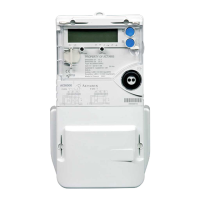7.6. Calendar
The calendar provides a flexible and configurable switching regime that handles up to sixteen energy rate
switches per day. The calendar also has the ability to apply different energy rate regimes during different
seasons of the year and on designated individual days.
Two completely separate calendar switching regimes are available and can be programmed into the meter:
Current
The switching regime currently in use by the meter.
Future (latent)
An alternative switching regime that will be used by the meter once a pre-programmed due date is reached.
This feature accommodates any contractually agreed energy rate changes and automatically applies them when
they are due to come into force. At the due date, the future calendar becomes the current one; a further future
calendar can then be programmed into the meter.
7.7. Energy rate switching
The contract between the customer and the utility will usually specify how many energy rates are available and at
what times of the day these rates can be applied. These energy rate regimes are known as tariffs.
Tariffs are defined and downloaded to the meter using the meter support tool. New tariffs can be defined and
loaded at any time.
A tariff specifies a set of energy and demand rates for one energy quantity and only energy registers associated
with those rates are updated; all other energy registers are not modified. For billing purposes, each tariff is
associated to an energy cost.
The real-time clock and calendar enable the meter to perform Time-Of-Use (TOU) energy rate switching under
control of these programmable tariff regimes.
7.7.1. Daylight saving
The meter can be programmed to follow seasonally-based changes in local time, generally referred to as
Daylight Saving Time (DST) or Summer Time.
Where the facility is enabled, the meter clock times will be advanced and retarded automatically by up to 2 hours
each year.
The DST configuration can be defined in a number of ways to allow for use in both the Northern and Southern
hemispheres and accommodate the different rules that apply in different countries.
Generic
All the date parameters for the DST transitions are individually programmable.
Programmed
Specific dates of change for the DST transitions can be chosen for each year. Up to five years values can be
programmed in advance.
Generic with season
The individually programmable DST transition dates are linked to a pre-defined season value.
Programmed with season
The specific dates of change for the DST transitions are linked to a pre-defined season value.

